M. Rasmussen et al. “The genome of a Late Pleistocene human from a Clovis burial site in western Montana,” Nature, doi:10.1038/nature13025, 2014.
http://www.nature.com/nature/journal/v506/n7487/full/nature13025.html?WT.ec_id=NATURE-20140213
M. Rasmussen et al. (2014)- Supplementary Information
"...The date on Anzick-1 cranial bone (10,705±35) differs from the average date for the rods (11,035±45). Their respective calibrated age ranges are 12,722 to 12,590 calendar years BP (Anzick-1) and 13,039 to 12,763 calendar years BP (antler rods) ⎯ values that do not overlap at the 95.4% confidence interval..."
"...Mitochondrial DNA (mtDNA) sequencing showed substitutions that characterize the mtDNA of Anzick-1 individual as a member of sub-haplogroup D4h3a17..."
"...The D4h3a branch [with an age estimate of 13,000 +/- 2600 years57] encompasses all Native American D4h3 mtDNAs (including mtDNA of Anzick-1) and has been mostly found in South America (Chile, Peru, Ecuador, Bolivia, Brazil), and to a much lesser extent also from Mexico and California (see the spatial distribution of D4h3a in Fig. 3 in53). The highest frequency of D4h3a has been found from Cayapa Amerinds from Ecuador (22%)..."
"... The Anzick-1 individual shares most ancestry with Native Americans with small patches shared with Asians and less with Europeans..."
"... The same analyses were performed on the modern Native American genomes generated for this study. While the two Karitiana genomes showed very high Native American ancestry, the Mayan individual showed a proportion of European ancestry of 12% ..."
"...Anzick-1 individual is clearly most closely related to modern-day Native American populations. However, this affinity is weaker in 7 of the 52 Native American populations in the data: Aleutians, East Greenlanders, West Greenlanders, Chipewyan, Algonquin, Cree, and Ojibwa (Figure 2a). In Eurasia, genetic affinity with the Anzick-1 individual decreases with distance from the Bering Strait (Figure 2a)..."
"...ancestry of the three Northern Amerind-speaking populations Algonquin, Cree, and Ojibwa to be entirely from the same migration that gave rise to Central and Southern American populations..."
"...We found that Central and South American populations all share a closer genetic history with the Anzick-1 individual than they do with modern-day North American individuals (Native American groups are skewed towards Anzick-1 from the 1:1 baseline). This supports the results above of a shared genetic history between the Anzick-1 individual and Central and Southern American groups that is not shared with the more Northerly groups in the data set..."
"...There is no evidence for Siberian gene flow into the Northern Amerinds consistent with the findings of Reich et al.72 using the same Native American data and a very similar approach..."
Thus, the data support a simple tree-like model where modern-day Southern and Central Native Americans are more closely related to the Anzick-1 individual than they are to modern-day Northern Native Americans.
http://www.nature.com/nature/journal/v506/n7487/extref/nature13025-s1.pdf
Kashani et al. (2012)
"...haplogroup X2a, whose restricted distribution to northern North America appears to be the result of
its peculiar entry route..."
"...X2g and until now has been described only in a single Ojibwa sample from Canada..."
http://www.ncbi.nlm.nih.gov/pubmed/22024980
Reidla et al. (2003)
"...Haplogroup X is an exception to this pattern of limited geographical distribution. It is found, generally at
low frequencies, in both West Eurasians (Richards et al. 2000) and some northern groups of Native Americans but, intriguingly, it is absent in modern north Siberian and East Asian populations..."
"...The transition at np 200 was seen in virtually all previously analyzed Native American haplogroup X mtDNAs, whereas the transition at np 16213 was absent in some of the Ojibwa described by
Brown et al. (1998). We surveyed our Old World haplogroup X mtDNAs for the five diagnostic X2a mutations (table 2) and found a match only for the transition at np 12397 in a single X2* sequence from Iran. In a parsimony tree, this Iranian mtDNA would share a common ancestor with the Native American clade..."
"... two complete Native American X sequences (from one Navajo and one Ojibwa)..."
http://www.ncbi.nlm.nih.gov/pmc/articles/PMC1180497/
low frequencies, in both West Eurasians (Richards et al. 2000) and some northern groups of Native Americans but, intriguingly, it is absent in modern north Siberian and East Asian populations..."
"...The transition at np 200 was seen in virtually all previously analyzed Native American haplogroup X mtDNAs, whereas the transition at np 16213 was absent in some of the Ojibwa described by
Brown et al. (1998). We surveyed our Old World haplogroup X mtDNAs for the five diagnostic X2a mutations (table 2) and found a match only for the transition at np 12397 in a single X2* sequence from Iran. In a parsimony tree, this Iranian mtDNA would share a common ancestor with the Native American clade..."
"... two complete Native American X sequences (from one Navajo and one Ojibwa)..."
http://www.ncbi.nlm.nih.gov/pmc/articles/PMC1180497/
Waters, M. and Stafford, T. 2007 Redefining the age of Clovis: implications for the peopling of the Americas. Science 315:1122–6
"... Anzick, Montana: The Anzick site in Montana is
reported to be a Clovis burial and cache. At
Anzick, 12 radiocarbon dates were obtained from the cranial elements of a purported Clovis
infant skeleton and 2 dates on associated bone foreshafts. Collagen extracted from the
foreshafts yielded an average age of 11,040 + 35 14C yr B.P. (S7). The human skeletal
remains were dated during three separate research programs. The first batch of seven dates
on bone comprise five chemical fractions that were considered reliable and averaged to
10,680 + 50 14C yr B.P. (S2). Later, a single purified collagen sample yielded a date of
11,550 + 60 14C yr B.P. (CAMS-35912). This measurement is rejected because subsequent
dating of the same XAD fraction and preceding fractions from newly sampled bone did not
replicate the 11,550 14C yr B.P. result. The source of the contaminating 14C-depleted carbon
is unknown. A more recent series of dates from a single cranial fragment provided four new
radiocarbon ages. These fractions confirm previous date estimates for the skeleton of
10,705 + 35 14C yr B.P. The 14C dates on the skeleton versus the dates on the bone
foreshafts suggest that the skeletal remains and Clovis artifacts may not be related
and that the foreshaft ages more accurately date the site. The 10,700 year old human
remains could post-date the Clovis cache, but additional research is needed to resolve this
issue. A more recent, late Paleoindian or early Archaic human skeleton was also found at
the site (S7). The association of any of the human remains with the Clovis cache is
problematic because the site had been excavated accidentally with heavy machinery before
the human bones and artifacts were recognized and later recovered at some distance from the
actual site. Thus, the directly dated Clovis artifacts—the foreshafts—appear to accurately date the site..."
Anzick, 12 radiocarbon dates were obtained from the cranial elements of a purported Clovis
infant skeleton and 2 dates on associated bone foreshafts. Collagen extracted from the
foreshafts yielded an average age of 11,040 + 35 14C yr B.P. (S7). The human skeletal
remains were dated during three separate research programs. The first batch of seven dates
on bone comprise five chemical fractions that were considered reliable and averaged to
10,680 + 50 14C yr B.P. (S2). Later, a single purified collagen sample yielded a date of
11,550 + 60 14C yr B.P. (CAMS-35912). This measurement is rejected because subsequent
dating of the same XAD fraction and preceding fractions from newly sampled bone did not
replicate the 11,550 14C yr B.P. result. The source of the contaminating 14C-depleted carbon
is unknown. A more recent series of dates from a single cranial fragment provided four new
radiocarbon ages. These fractions confirm previous date estimates for the skeleton of
10,705 + 35 14C yr B.P. The 14C dates on the skeleton versus the dates on the bone
foreshafts suggest that the skeletal remains and Clovis artifacts may not be related
and that the foreshaft ages more accurately date the site. The 10,700 year old human
remains could post-date the Clovis cache, but additional research is needed to resolve this
issue. A more recent, late Paleoindian or early Archaic human skeleton was also found at
the site (S7). The association of any of the human remains with the Clovis cache is
problematic because the site had been excavated accidentally with heavy machinery before
the human bones and artifacts were recognized and later recovered at some distance from the
actual site. Thus, the directly dated Clovis artifacts—the foreshafts—appear to accurately date the site..."
Raghavan M. et al. Upper Palaeolithic Siberian genome reveals dual ancestry of Native Americans. Nature
The origins of the First Americans remain contentious. Although Native Americans seem to be genetically most closely related to east Asians1, 2, 3, there is no consensus with regard to which specific Old World populations they are closest to4, 5, 6, 7, 8. Here we sequence the draft genome of an approximately 24,000-year-old individual (MA-1), from Mal’ta in south-central Siberia9, to an average depth of 1×. To our knowledge this is the oldest anatomically modern human genome reported to date. The MA-1 mitochondrial genome belongs to haplogroup U, which has also been found at high frequency among Upper Palaeolithic and Mesolithic European hunter-gatherers10, 11, 12, and the Y chromosome of MA-1 is basal to modern-day western Eurasians and near the root of most Native American lineages5. Similarly, we find autosomal evidence that MA-1 is basal to modern-day western Eurasians and genetically closely related to modern-day Native Americans, with no close affinity to east Asians. This suggests that populations related to contemporary western Eurasians had a more north-easterly distribution 24,000 years ago than commonly thought. Furthermore, we estimate that 14 to 38% of Native American ancestry may originate through gene flow from this ancient population. This is likely to have occurred after the divergence of Native American ancestors from east Asian ancestors, but before the diversification of Native American populations in the New World. Gene flow from the MA-1 lineage into Native American ancestors could explain why several crania from the First Americans have been reported as bearing morphological characteristics that do not resemble those of east Asians2, 13. Sequencing of another south-central Siberian, Afontova Gora-2 dating to approximately 17,000 years ago14, revealed similar autosomal genetic signatures as MA-1, suggesting that the region was continuously occupied by humans throughout the Last Glacial Maximum. Our findings reveal that western Eurasian genetic signatures in modern-day Native Americans derive not only from post-Columbian admixture, as commonly thought, but also from a mixed ancestry of the First Americans.
Raghavan M. et al. Upper Palaeolithic Siberian genome reveals dual ancestry of Native Americans. Nature
The Mal'ta boy was buried with a variety of artefacts, including a Venus figurine

http://www.nihilum.republika.pl/W_malta_10.htm
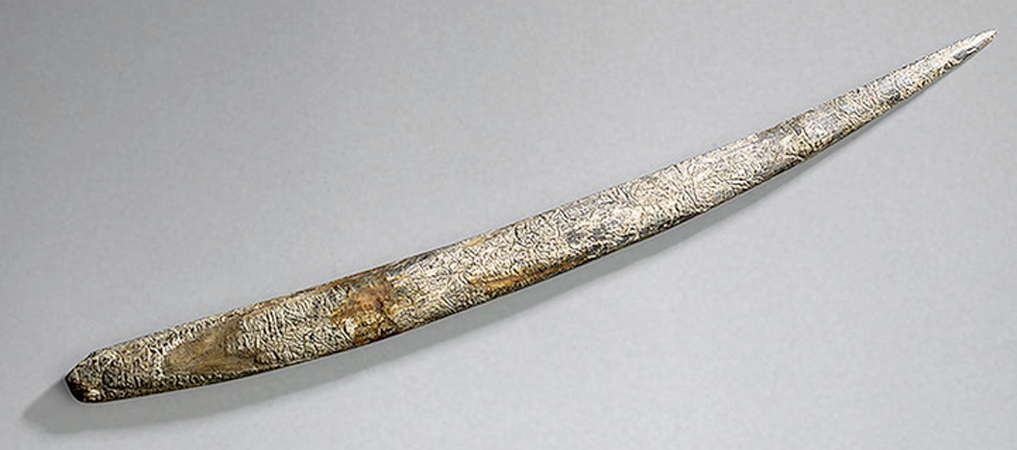
http://donsmaps.com/images24/maltahermitagespike.jpg
Spike. Mammoth tusk; carved. Length 300 mm.
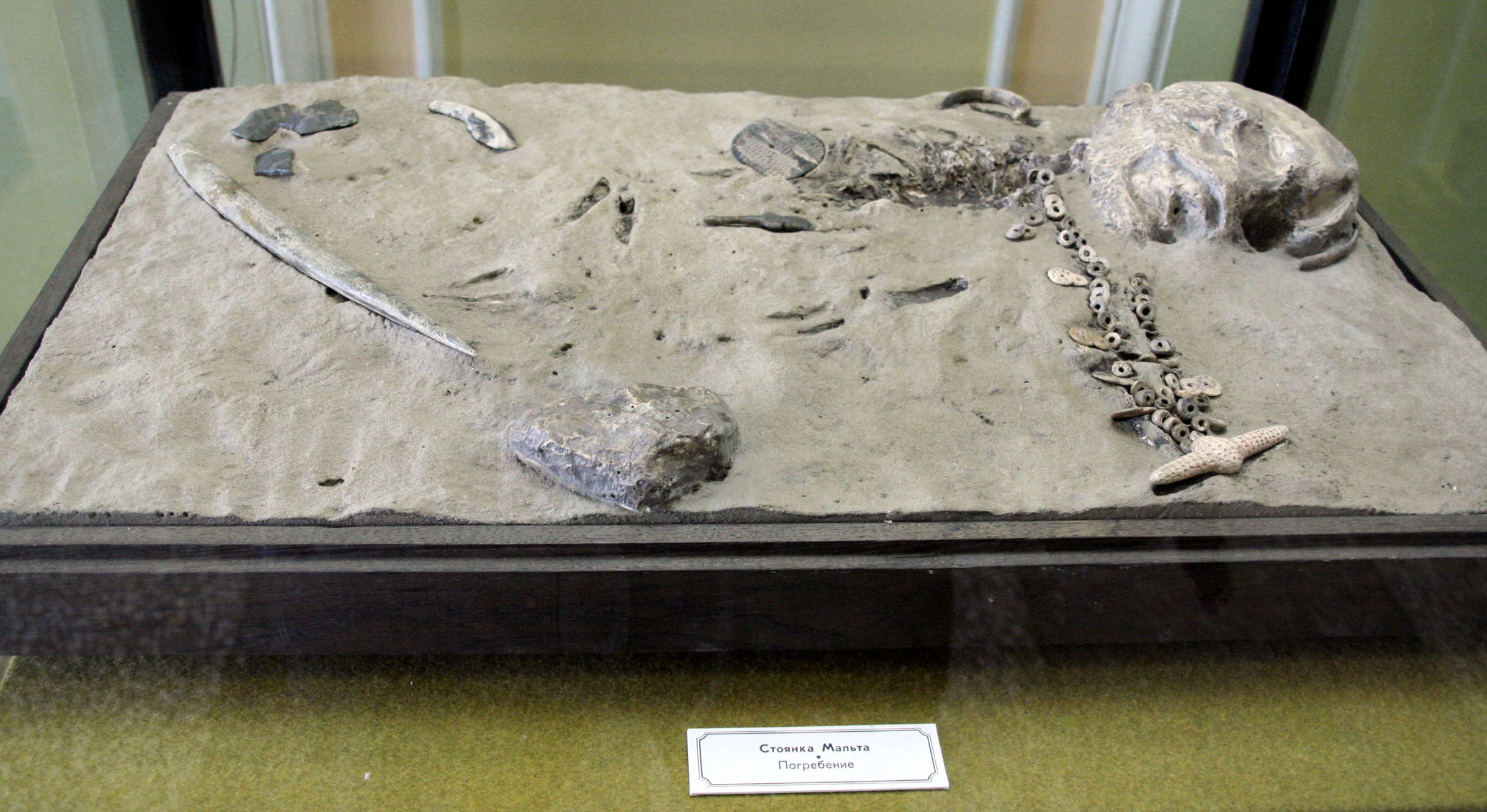
Replica of the child's grave at Mal'ta.
http://donsmaps.com/images26/thehermitage182.jpg
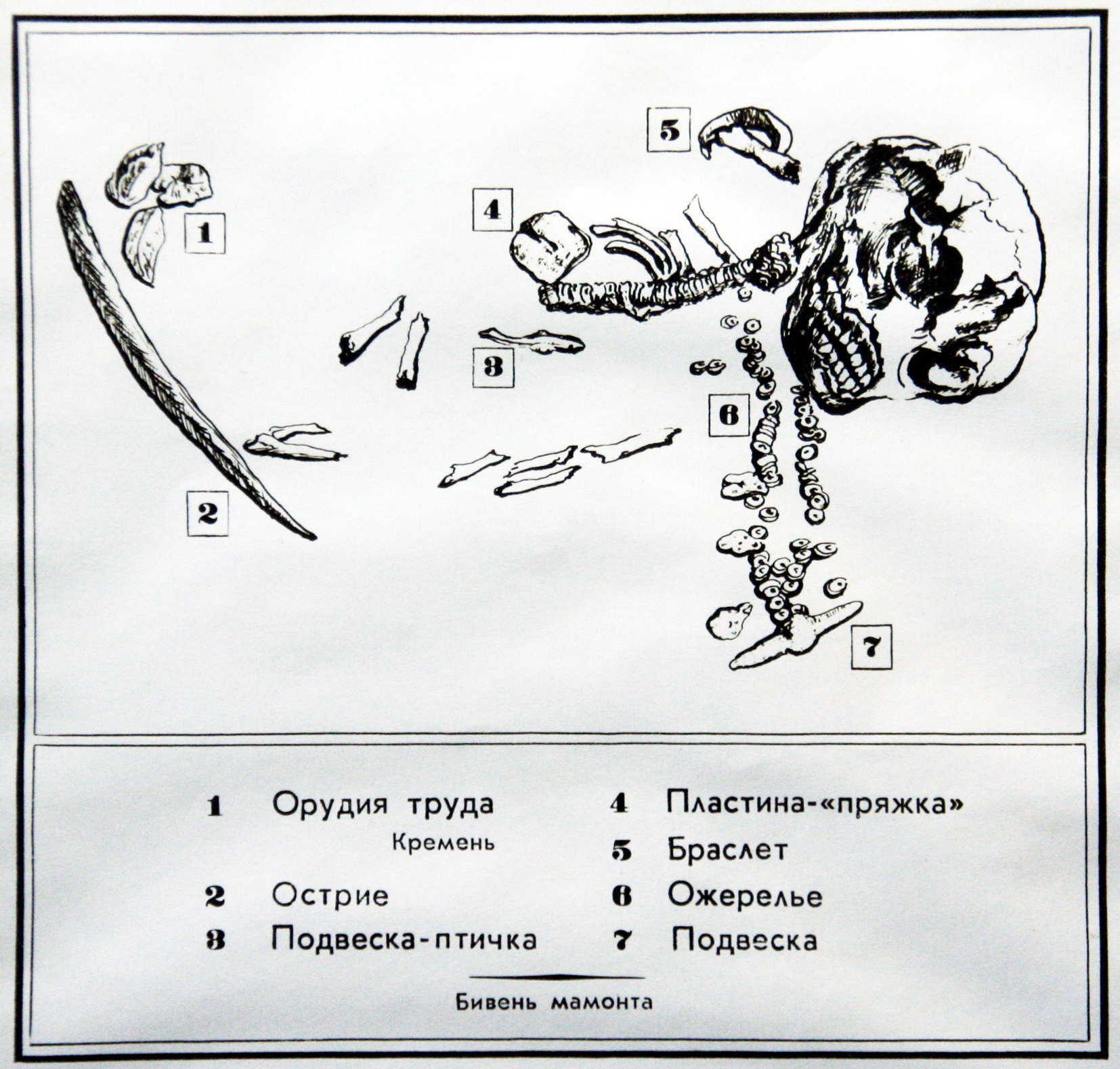
http://donsmaps.com/images26/thehermitage181.jpg
Diagram of the child's grave at Mal'ta.
1 - Flint Tools
2 - Point
3 - Bird Pendant
4 - Plate 'Buckle'
5 - Bracelet
6 - Necklace
7 - Pendant on the end of the necklace
Photo: Vladimir Gorodnjanski 2007
Source: The Hermitage Museum, Saint Petersburg

http://donsmaps.com/images24/maltabracelet.jpg
A good example of such finds is this complete necklace, found as a grave good of the child burial. The child was sprinkled with red ochre and charcoal. The necklace consists of one central and six secondary pendants and 120 flat beads. The surface of the pendants is entirely covered with pit-ornamentation.
Photo and text: http://www.folklore.ee/folklore/vol18/pa06.pdf
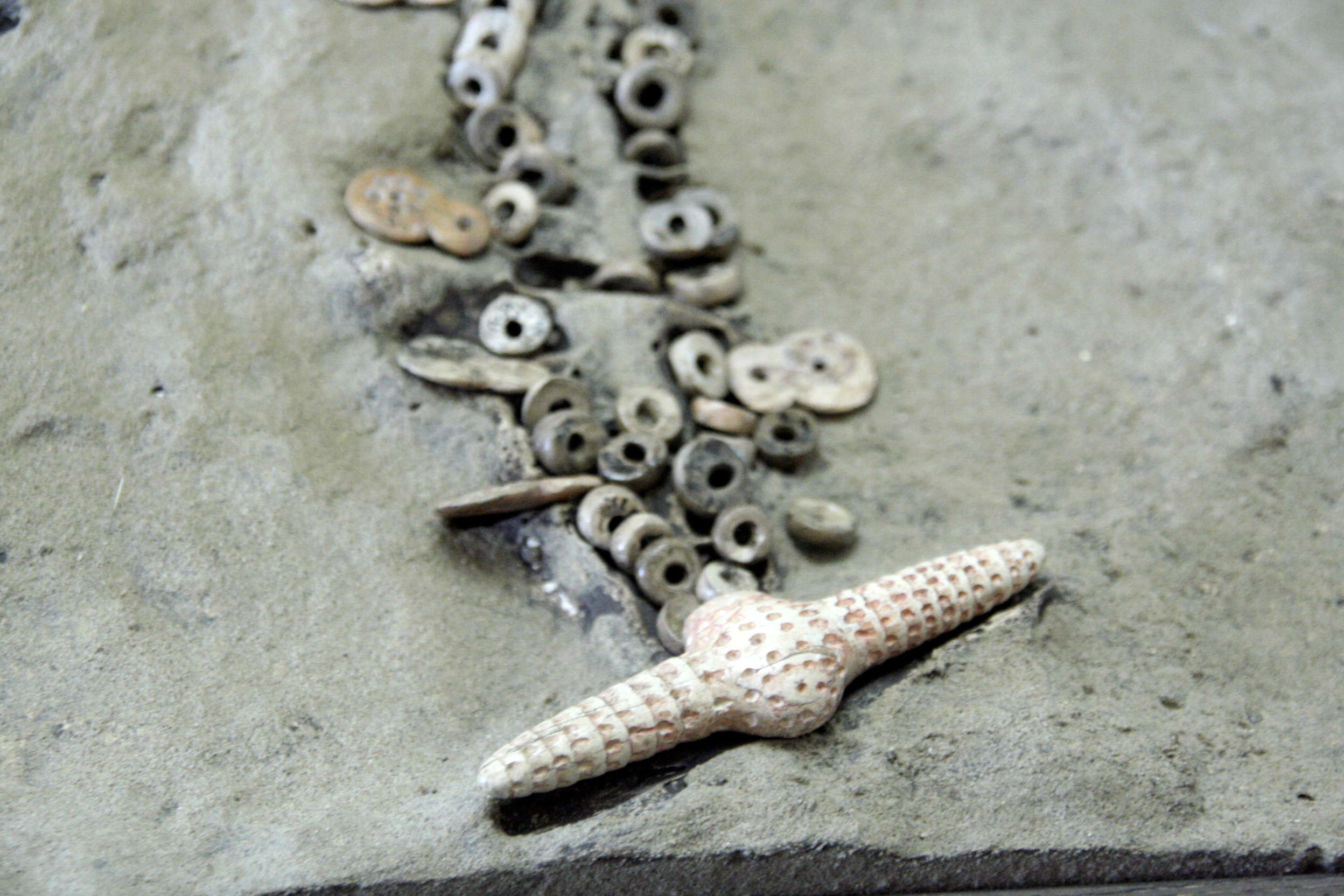
http://donsmaps.com/images26/thehermitage185.jpg
The pendant at the end of the Mal'ta necklace.
Photo: Vladimir Gorodnjanski 2007
Source: The Hermitage Museum, Saint Petersburg
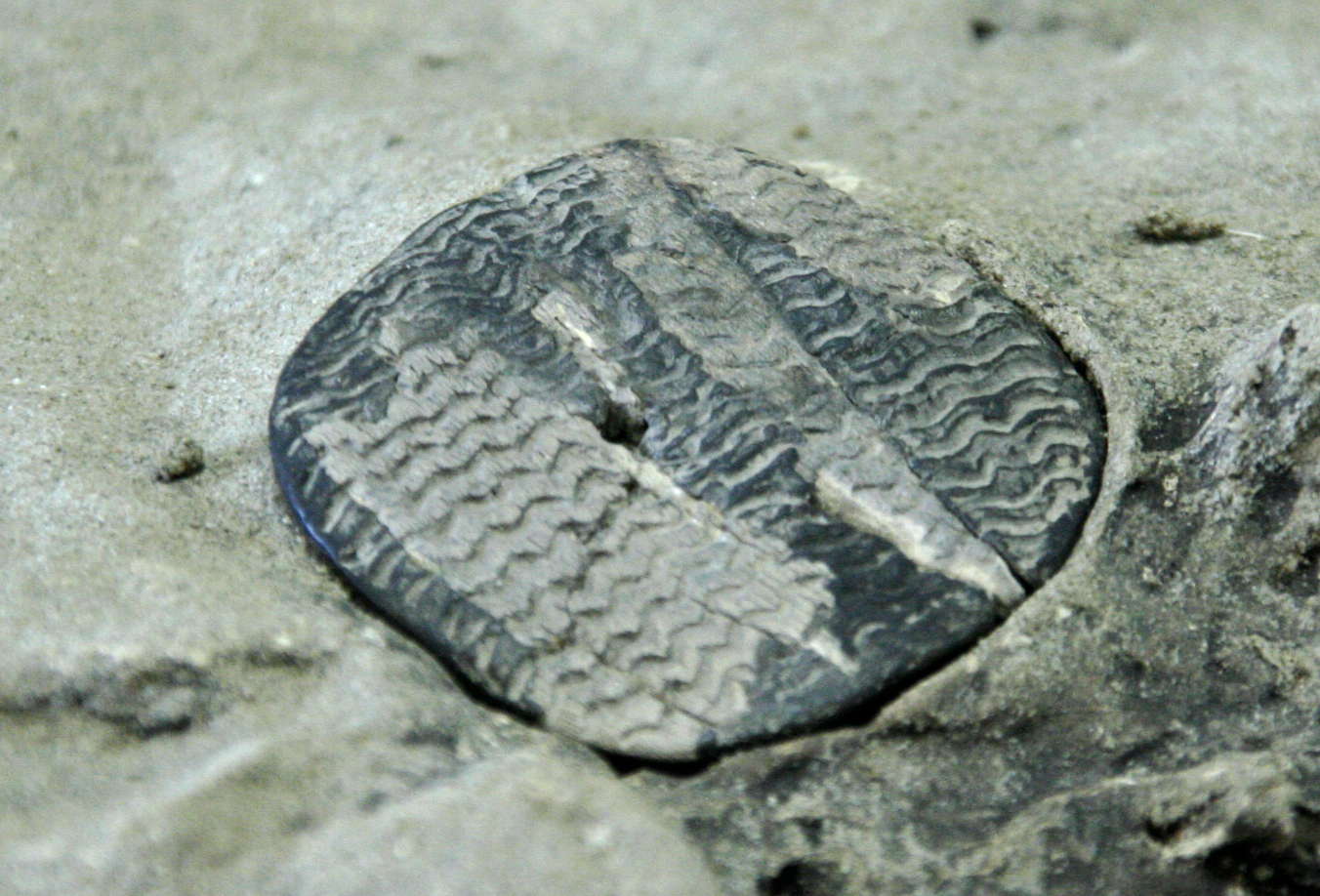
http://donsmaps.com/images26/thehermitage183.jpg
Plate, or buckle. This may have been a breast ornament.
Photo: Vladimir Gorodnjanski 2007
Source: The Hermitage Museum, Saint Petersburg
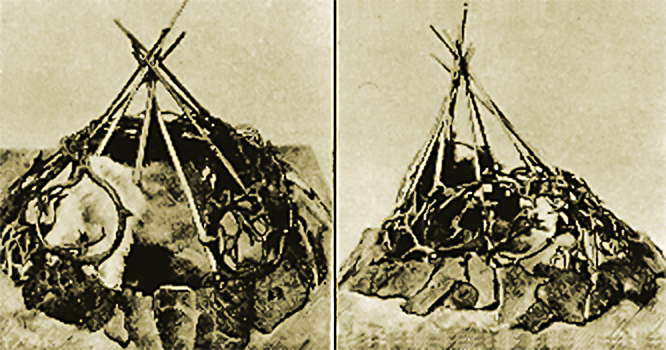
http://donsmaps.com/images25/maltatent.jpg
Circular tents from Mal'ta, Siberia. These animal hide covered structures were bolstered with stones at the base. Photo: http://www.afghanchamber.com/history/stoneages.htm

http://donsmaps.com/images25/stonecirclehut.jpg
Circular dwelling made with a stone wall base, from Mal'ta, Siberia.
Photo: http://www.afghanchamber.com/history/stoneages.htm
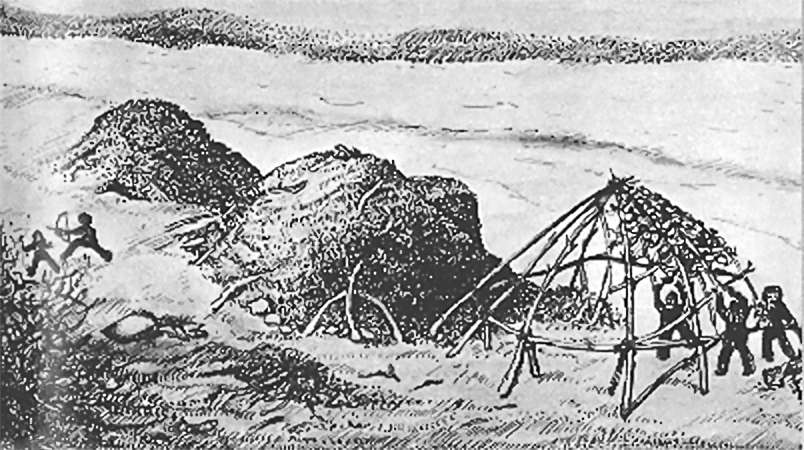
http://donsmaps.com/images25/tentsburet.jpg
Upper Paleolithic huts from Buret', Siberia. These structures date from about 12 000 BP
Photo: http://www.afghanchamber.com/history/stoneages.htm
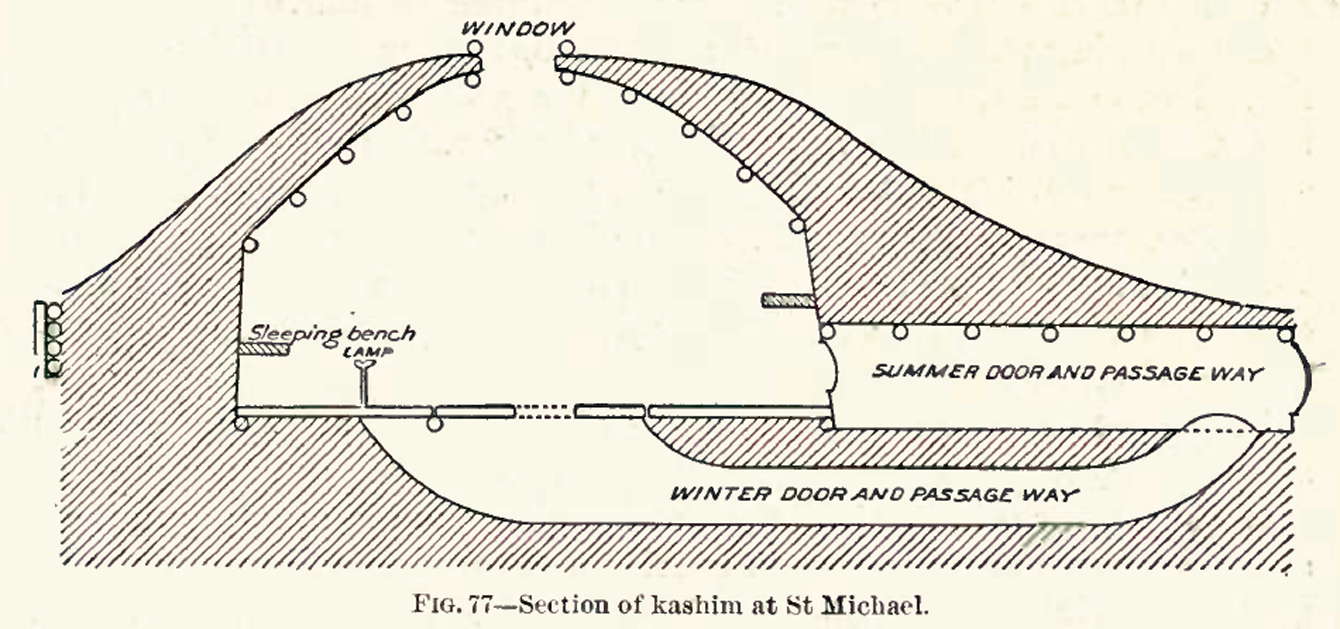
http://donsmaps.com/images24/kashim.jpg
Section of a house in Siberia, possibly similar to those at Buret', showing the corridor to the outside, and the fact that there were two modes of use, one for summer, and the other for winter, which cut down on the loss of heat from the building.
Photo: Nelson (1881)
References
- Abramova Z., 1995: L'Art paléolithique d'Europe orientale et de Sibérie., Grenoble: Jérôme Millon.
- Bednarik R., 2010: An overview of Asian palaeoart of the Pleistocene, IFRAO Congress, September 2010 – Symposium: Pleistocene art of Asia (Pre-Acts)
- Childe, V.G., 1950: Cave Men's Buildings Antiquity, Volume: 24 Number: 93 Page: 4–11
- Clark G., 1967: The Stone Age Hunters, McGraw-Hill, 1967
- Cohen C., 2003: La femme des origines. Images de la femme dans la préhistoire occidentale,, Paris, Belin-Herscher, 2003, 191 pages.
- Delporte H., 1979: L'image de la femme dans l'art préhistorique, Paris, Picard.
- Jelinek J., 1972: Das grosse Bilderlexikon des Menschen in der Vorzeit, Gütersloh. Bertelsmann-Lexikon-Verlag, P. 333
- Nelson, E., 1881: Eskimos about the Bering Strait
- Soffer, O., Adovasio, M., Hyland D., 2001: Reply to 'More on the Venus Figurines', Current Anthropology, Volume 42, Number 3, June 2001, pp 410-412
http://donsmaps.com/malta.html
Anzick Artifacts





Charlie Hatchett
www.pre-clovis.com
www.forum.pre-clovis.com
www.blog.pre-clovis.com